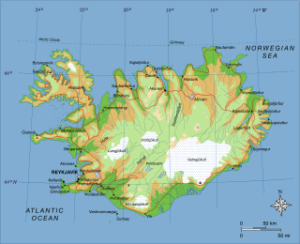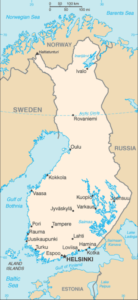
When it comes to road safety in the United States, not all states are created equally. While the overall death rate per capita from motor vehicle crashes in the US is approximately 10.2 deaths per 100,000 people (in 2014), the death rates per capita from one state to the next can vary significantly.
While the death rate per capita isn’t a perfect measure of driving risk, it is the most common way of comparing the risk of being killed by auto traffic from one place to the next, and it’s the best general way of judging one’s risk of death by traffic as an average citizen in a given area. With that in mind, which states are the safest, which are the most dangerous, and how do they compare to foreign countries with similar populations?
The most dangerous state for drivers per capita in 2014
Wyoming won the dubious distinction in 2014 of being the state with the highest death rate per capita in the US, with a fatality rate of 25.7 individuals per 100,000. With a population of 584,153 people, that translated to 150 deaths. In comparison, in 2014, Iceland, with a population of 329,100 people, experienced its best year since 1939 with 4 deaths, or a fatality rate of 1.22 per 100,000. Both countries have a nearly identical population density, with 6 people / sq. mile in Wyoming and 8.3 / sq. mi. in Iceland. People are spread out about the same way, and there are a similar number of people…but the people are dying in one patch of land, and living in the other.

What a difference! This is a nation with a similar population size to that of a local state, yet one where the average citizen was 21 times less likely to die by auto. Had Wyoming rate been as low as Iceland’s in 2014, only 5 individuals would have died instead of 150.
That’s huge.
In comparison, with a road fatality rate of 25.7 per 100,000 individuals, Wyoming was as unsafe as a number of nations most people in the United States would think they had nothing in common with, like South Africa (25.1), Ethiopia (25.3), Somalia (25.4), and Mali (25.6), per the WHO.
Here’s what an Icelandic official had to say about this figure:
“Our goal is naturally that no one dies in traffic and four fatal accidents are four too many,” said Ágúst Mogensen, chief of investigation of traffic accidents at the Icelandic Transportation Safety Board.
Even so, one can point out this achievement in traffic safety and hopefully, we will experience a year when there are no fatal accidents,” he concluded.
It sounds a lot like what a Norwegian official said about their country’s progress last year when they experienced one of their lowest road fatality rates in history. However, you’d be hard pressed to find a similar statement from officials in Wyoming, unfortunately, and not just because Wyoming came in last.
Year after year, there’s a much greater acceptance of road fatalities in the US compared to prevailing attitudes in many of our fellow wealthy countries, and it’s related to the relentless inevitability of the automobile. There aren’t really any other options to driving throughout large parts of the country, and the auto is associated with our national identity to a much greater degree than is the case in many of our fellow wealthy nations.
What if Iceland just got lucky in 2014?
That’s a great question! Maybe the 1.22 road fatality rate was a fluke. The following year, Iceland would experience many more road fatalities, putting this theory to the test. However, while the Icelandic rate jumped significantly..it still remained far, far better than the Wyoming rate. In 2015, Iceland had an estimated population of 329,425 people, and suffered 16 fatalities, a figure fourfold higher than that in 2014. However, this still led to a much better road fatality rate at 4.86 per 100,000.
How good is a bad year in Iceland (it was their worst year since 2009, where they experienced 17 deaths) compared to a good year for a US state? Let’s take a look at the safest states per capita in 2014 and find out.
The safest states for drivers per capita in 2014
Not counting the District of Columbia, which is, for all intents and purposes, a city and not a state, the states with the lowest death rate per capita in 2014 were Massachusetts and Rhode Island, both of which had road fatality rates of 4.9, or less than half of the overall US road fatality rate of 10.2.

You’ll note that 4.9 is essentially the same road fatality rate as that experienced by Iceland last year (2015), which was not a particularly good year at all for Iceland. That aside, it’s something to be proud of; the safest states in the US, in terms of the average person’s risk of dying via auto trauma, were as safe as one of the safest countries on the planet. Massachusetts had a population of 6,745,408, and suffered 328 deaths. Rhode Island, with a much smaller population of 1,055,173, suffered 52 deaths. New York was barely edged out in 3rd place, with a population of 19,746,227, a road fatality rate of 5.3 per 100,000, and 1,039 deaths.
To put things another way, your odds of dying from a road crash in Mass. and Rhode Island in 2014 were equivalent to your odds of dying from a road crash in Finland in 2013; the population was roughly 5,375,000 while there were 258 deaths, producing a rate of 4.8, per the International Transport Forum, which compares 38 nations annually for road safety trends.
What the numbers tell us is that there are places in the US where your risks of dying from auto traffic are as low as they are in some of the safest areas overseas. There are safer European nations than Iceland and Finland; in 2013, Sweden, the UK, Switzerland, the Netherlands, Denmark, Israel, Spain, and Norway all had road fatality rates beneath 4 per 100,000. However, even if the best US states weren’t fully comparable to the safest countries per capita, they came close. Unfortunately, there were also lots of states that did very, very poorly. As noted, Wyoming was no safer than Somalia for drivers; there were plenty of other states that also had surprising equivalents across the globe in terms of road safety.
On a positive note, there were a number of states that were safer than the US average of 10.2 in 2014: Alaska (9.9), California (7.9), Colorado (9.1), Connecticut (6.9), Hawaii (6.7), Illinois (7.2), Maine (9.8), Maryland (7.4), Massachusetts and Rhode Island (4.9), Michigan (9.1), Minnesota (6.6), New Hampshire (7.2), New Jersey (6.2), New York (5.3), Ohio (8.7), Oregon (9), Pennsylvania (9.3), Utah (8.7), Vermont (7.0), Virginia (8.4), Washington (6.5), and Wisconsin (8.8).
That said, we have much work to do.
What do I do to keep my family safe (whether when driving, walking, or cycling) if we live in an unsafe state?
This is a great question, and it’s one I frequently get from parents concerned about overall road safety. Keep in mind that the above statistics involve people killed by auto traffic whether or not they were in vehicles themselves. In other words, pedestrians and cyclists also feature into the numbers.
When driving, I typically suggest to stick to the basics of driving safely. In particular, making sure every occupant is buckled on every drive, only driving with a 0.00% BAC, and driving the speed limit every single time will make your occupants safer than those of 90% of vehicle occupants on the road.
I would completely avoid motorcycles and scooters. They offer no more protection than bicycles while traveling at much higher speeds among much heavier and more fortified vehicles. It’s the worst of both worlds.
When navigating roadways as a pedestrian, only cross at crosswalks, look both ways, use sidewalks whenever available (I’d go as far as to recommend avoiding any roadways that don’t feature them), and only walk during the daytime.
I’d recommend cycling only on streets with speed limits of 20 mph or below. For streets with higher speed limits, I’d avoid cycling except on protected (segregated) lanes. Unfortunately, these conditions are very hard to meet in most places in the United States, which makes it hard to recommend cycling in many to most parts of the country. We have a long way to go in our respect toward the most vulnerable members of the road.
—
If you find the information on car safety, recommended car seats, and car seat reviews on this car seat blog helpful, you can shop through this Amazon link for any purchases, car seat-related or not. Canadians can shop through this link for Canadian purchases.

